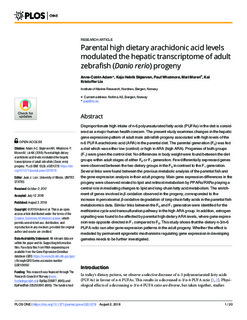| dc.contributor.author | Adam, Anne-Catrin | |
| dc.contributor.author | Skjærven, Kaja Helvik | |
| dc.contributor.author | Whatmore, Paul | |
| dc.contributor.author | Moren, Mari | |
| dc.contributor.author | Lie, Kai Kristoffer | |
| dc.date.accessioned | 2018-10-08T14:40:33Z | |
| dc.date.available | 2018-10-08T14:40:33Z | |
| dc.date.created | 2018-09-06T14:07:54Z | |
| dc.date.issued | 2018 | |
| dc.identifier.issn | 1932-6203 | |
| dc.identifier.uri | http://hdl.handle.net/11250/2566966 | |
| dc.description.abstract | Disproportionate high intake of n-6 polyunsaturated fatty acids (PUFAs) in the diet is considered as a major human health concern. The present study examines changes in the hepatic gene expression pattern of adult male zebrafish progeny associated with high levels of the n-6 PUFA arachidonic acid (ARA) in the parental diet. The parental generation (F0) was fed a diet which was either low (control) or high in ARA (high ARA). Progenies of both groups (F1) were given the control diet. No differences in body weight were found between the diet groups within adult stages of either F0 or F1 generation. Few differentially expressed genes were observed between the two dietary groups in the F0 in contrast to the F1 generation. Several links were found between the previous metabolic analysis of the parental fish and the gene expression analysis in their adult progeny. Main gene expression differences in the progeny were observed related to lipid and retinoid metabolism by PPARα/RXRα playing a central role in mediating changes to lipid and long-chain fatty acid metabolism. The enrichment of genes involved in β-oxidation observed in the progeny, corresponded to the increase in peroxisomal β-oxidative degradation of long-chain fatty acids in the parental fish metabolomics data. Similar links between the F0 and F1 generation were identified for the methionine cycle and transsulfuration pathway in the high ARA group. In addition, estrogen signalling was found to be affected by parental high dietary ARA levels, where gene expression was opposite directed in F1 compared to F0. This study shows that the dietary n-3/n-6 PUFA ratio can alter gene expression patterns in the adult progeny. Whether the effect is mediated by permanent epigenetic mechanisms regulating gene expression in developing gametes needs to be further investigated. | nb_NO |
| dc.language.iso | eng | nb_NO |
| dc.title | Parental high dietary arachidonic acid levels modulated the hepatic transcriptome of adult zebrafish (Danio rerio) progeny | nb_NO |
| dc.title.alternative | Parental high dietary arachidonic acid levels modulated the hepatic transcriptome of adult zebrafish (Danio rerio) progeny | nb_NO |
| dc.type | Journal article | nb_NO |
| dc.type | Peer reviewed | nb_NO |
| dc.description.version | publishedVersion | nb_NO |
| dc.source.volume | 13 | nb_NO |
| dc.source.journal | PLoS ONE | nb_NO |
| dc.source.issue | 8 | nb_NO |
| dc.identifier.doi | 10.1371/journal.pone.0201278 | |
| dc.identifier.cristin | 1607346 | |
| dc.relation.project | Norges forskningsråd: 228877 | nb_NO |
| dc.relation.project | Norges forskningsråd: 225250 | nb_NO |
| cristin.unitcode | 7431,31,0,0 | |
| cristin.unitcode | 7431,32,0,0 | |
| cristin.unitcode | 7431,0,0,0 | |
| cristin.unitname | Behov og velferd | |
| cristin.unitname | Trygt fôr | |
| cristin.unitname | Havforskningsinstituttet | |
| cristin.ispublished | true | |
| cristin.fulltext | original | |
| cristin.qualitycode | 1 | |
